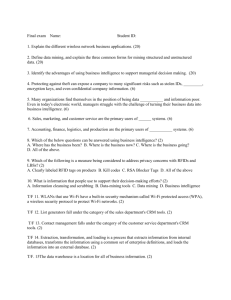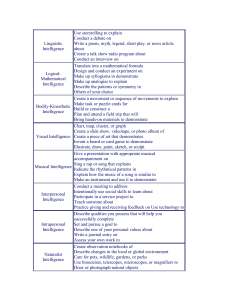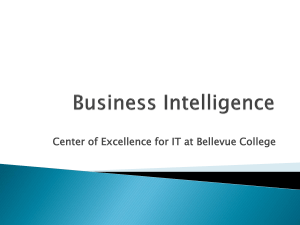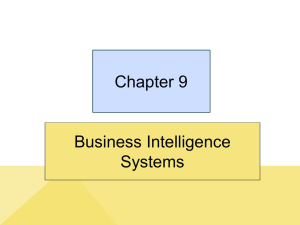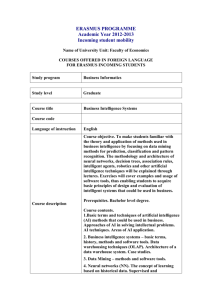Introduction to Business Intelligence
advertisement
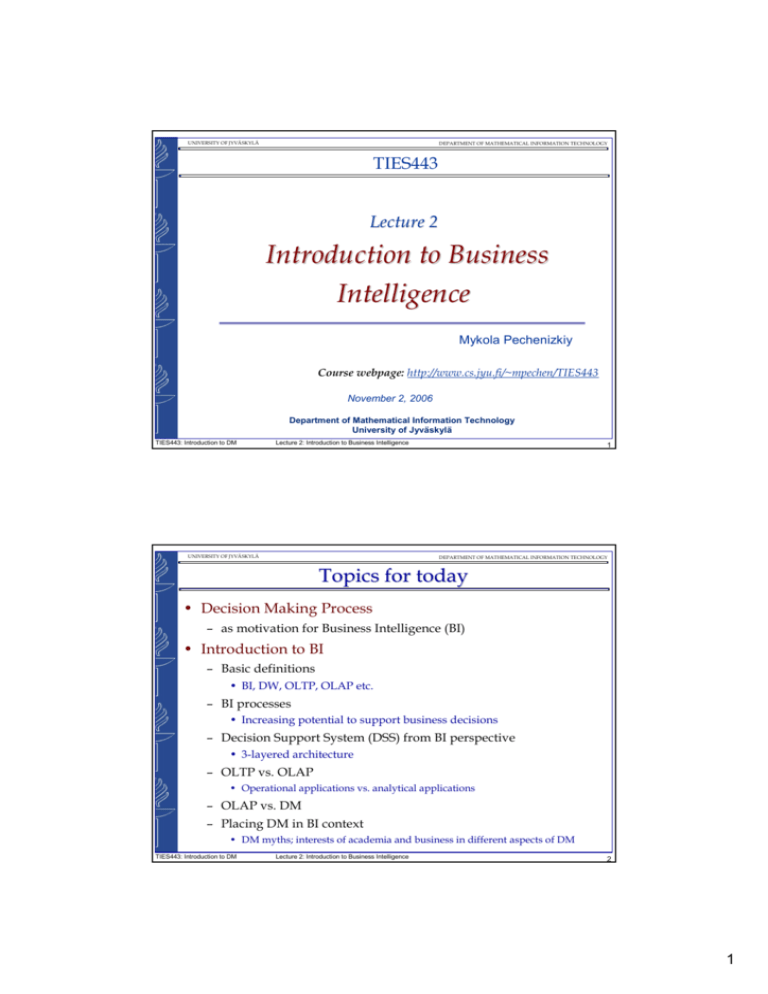
UNIVERSITY OF JYVÄSKYLÄ
DEPARTMENT OF MATHEMATICAL INFORMATION TECHNOLOGY
TIES443
Lecture 2
Introduction to Business
Intelligence
Mykola Pechenizkiy
Course webpage: http://www.cs.jyu.fi/~mpechen/TIES443
November 2, 2006
Department of Mathematical Information Technology
University of Jyväskylä
TIES443: Introduction to DM
Lecture 2: Introduction to Business Intelligence
UNIVERSITY OF JYVÄSKYLÄ
1
DEPARTMENT OF MATHEMATICAL INFORMATION TECHNOLOGY
Topics for today
• Decision Making Process
– as motivation for Business Intelligence (BI)
• Introduction to BI
– Basic definitions
• BI, DW, OLTP, OLAP etc.
– BI processes
• Increasing potential to support business decisions
– Decision Support System (DSS) from BI perspective
• 3-layered architecture
– OLTP vs. OLAP
• Operational applications vs. analytical applications
– OLAP vs. DM
– Placing DM in BI context
• DM myths; interests of academia and business in different aspects of DM
TIES443: Introduction to DM
Lecture 2: Introduction to Business Intelligence
2
1
UNIVERSITY OF JYVÄSKYLÄ
DEPARTMENT OF MATHEMATICAL INFORMATION TECHNOLOGY
Decision Making Process
• Decision making at different levels
– Operational
• Related to daily activities with short-term effect
• Structured decisions taken by lower management
– Tactical
• Semi-structured decisions taken by middle management
– Strategic
• Long-term effect
• Unstructured decisions taken by top management
• Decision making steps include
– Problem identification,
– Finding alternative solutions,
– Making a choice
• Information and knowledge form the backbone of the
decision making process
TIES443: Introduction to DM
Lecture 2: Introduction to Business Intelligence
UNIVERSITY OF JYVÄSKYLÄ
3
DEPARTMENT OF MATHEMATICAL INFORMATION TECHNOLOGY
Technology is needed “… to push information closer to the point of service to
enhance decision-making, and to make the data actionable” – SAS vision of
their customers’ needs
TIES443: Introduction to DM
Lecture 2: Introduction to Business Intelligence
4
2
UNIVERSITY OF JYVÄSKYLÄ
DEPARTMENT OF MATHEMATICAL INFORMATION TECHNOLOGY
Types of Knowledge Available
• Expert knowledge
– Common/contextual, possed/distributed among a few experts
– extensive training and/or experience
• Organizational knowledge
– Represents intricate relationships between components of an
organization
– Embodies all the human knowledge embedded within the
organization
– Captures other implicit knowledge as well
• Organizational knowledge is embedded in the
transactional data
• Knowledge Acquisition
– Knowledge elicitation (experts) vs. Knowledge discovery (data)
– Interviewing/observing a human expert vs. Data Mining for
• Identifying basic rules
– IF temperature < -35 AND time < 9.00 THEN don’t_go_to_lecture
TIES443: Introduction to DM
Lecture 2: Introduction to Business Intelligence
UNIVERSITY OF JYVÄSKYLÄ
5
DEPARTMENT OF MATHEMATICAL INFORMATION TECHNOLOGY
Pros and Cons of Knowledge Discovery
• Advantages
– Not dependent on one expert
– Based on actual performance
• If the expert made wrong decisions, those failures are pruned out
– Potentially, can capture all relevant knowledge
• Not just in-human knowledge
– Objective, not subjective
– Well understood in theory and practice
• Disadvantages
– Depends heavily on the data set used
• Noise in the data set can throw one off, GIGO
– Based on historical data
• If the future context changes, then performance can drop
• The underlying basic rule (theory) may never be discovered
TIES443: Introduction to DM
Lecture 2: Introduction to Business Intelligence
6
3
UNIVERSITY OF JYVÄSKYLÄ
DEPARTMENT OF MATHEMATICAL INFORMATION TECHNOLOGY
Motivation – Enabling Decision Support
• Decision Support - IT to help the knowledge worker
(executive, manager, analyst) make faster & better
decisions
• Organizations need various kinds of information to
support decisions
– Two types of applications:
• Operational applications
• Analytical applications
• Decision-making speed if an important success factor in
the information economy
• The problem is to find the right information and analyze it
TIES443: Introduction to DM
Lecture 2: Introduction to Business Intelligence
UNIVERSITY OF JYVÄSKYLÄ
7
DEPARTMENT OF MATHEMATICAL INFORMATION TECHNOLOGY
Basic Definitions
•
•
•
•
•
•
Business Intelligence
Data Warehouse
OLTP
OLAP
Data Mart
Data Cube
• More buzzwords in the following lecture on data
warehousing
TIES443: Introduction to DM
Lecture 2: Introduction to Business Intelligence
8
4
UNIVERSITY OF JYVÄSKYLÄ
DEPARTMENT OF MATHEMATICAL INFORMATION TECHNOLOGY
What Is Business Intelligence?
• Business Intelligence (BI) is
– the new technology for understanding the past & predicting
the future …
– a broad category of technologies that allows for
• gathering, storing, accessing & analyzing data to help business users
make better decisions
• analyzing business performance through data-driven insight
– a broad category of applications, which include the activities of
•
•
•
•
decision support systems
query and reporting
online analytical processing (OLAP)
statistical analysis, forecasting, and data mining.
• BI applications can be:
– mission-critical and integral to an enterprise's operations or
occasional to meet a special requirement
– enterprise-wide or local to one division, department, or project
– centrally initiated or driven by user demand
TIES443: Introduction to DM
UNIVERSITY OF JYVÄSKYLÄ
Lecture 2: Introduction to Business Intelligence
9
DEPARTMENT OF MATHEMATICAL INFORMATION TECHNOLOGY
One simple BI example
TIES443: Introduction to DM
http://exonous.typepad.com/mis/business_intelligence.jpg
Lecture 2: Introduction to Business Intelligence
10
5
UNIVERSITY OF JYVÄSKYLÄ
DEPARTMENT OF MATHEMATICAL INFORMATION TECHNOLOGY
What is Data Warehouse?
• Defined in many different ways, but not rigorously.
– A decision support database that is maintained separately from the
organization’s operational database
– A consistent database source that bring together information from
multiple sources for decision support queries
– Support information processing by providing a solid platform of
consolidated, historical data for analysis
• Data warehousing:
– The process of constructing and using data warehouses
• A data warehouse is based on a
multidimensional data model which
views data in the form of a data cube
• We will consider different aspect of
data warehousing in the following
lecture tomorrow
TIES443: Introduction to DM
Lecture 2: Introduction to Business Intelligence
UNIVERSITY OF JYVÄSKYLÄ
11
DEPARTMENT OF MATHEMATICAL INFORMATION TECHNOLOGY
Data Warehouse vs. Operational DBMS
• OLTP (on-line transaction processing)
– Major task of traditional relational DBMS
– Day-to-day operations: purchasing, inventory, banking, manufacturing,
payroll, registration, accounting, etc.
– Aims at reliable and efficient processing of a large number of transactions
and ensuring data consistency
• OLAP (on-line analytical processing)
– Major task of data warehouse system
– Data analysis and decision making
– Aims at efficient multidimensional processing of large data volumes
• Fast, interactive answers to large aggregate queries
• Distinct features (OLTP vs. OLAP):
–
–
–
–
–
User and system orientation: customer vs. market
Data contents: current, detailed vs. historical, consolidated
Database design: ER + application vs. star + subject
View: current, local vs. evolutionary, integrated
Access patterns: update vs. read-only but complex queries
TIES443: Introduction to DM
Lecture 2: Introduction to Business Intelligence
12
6
UNIVERSITY OF JYVÄSKYLÄ
DEPARTMENT OF MATHEMATICAL INFORMATION TECHNOLOGY
OLTP vs.
OLAP
User
Clerk, IT Professional
Knowledge worker
Function
Day to day operations
Decision support
DB Design
Application-oriented
Subject-oriented
Data
Current, Isolated
Historical, Consolidated
View
Detailed, Flat relational
Summarized, Multidimensional
Usage
Structured, Repetitive
Ad hoc
Unit of work
Short, Simple transaction
Complex query
Access
Read/write
Read Mostly
Operations
Index/hash on prim. Key
Lots of Scans
# Rec. accessed Tens
Millions
#Users
Thousands
Hundreds
Db size
100 MB-GB
100GB-TB
Metric
Trans. throughput
Query throughput, response
TIES443: Introduction to DM
Lecture 2: Introduction to Business Intelligence
UNIVERSITY OF JYVÄSKYLÄ
13
DEPARTMENT OF MATHEMATICAL INFORMATION TECHNOLOGY
Need of Data Warehousing (for OLAP)
• High performance for both systems
– DBMS— tuned for OLTP
• access methods, indexing, concurrency control, recovery
– Warehouse—tuned for OLAP
• complex OLAP queries, multidimensional view, consolidation.
• Different functions and different data
– Missing data: Decision support requires historical data which
operational DBs do not typically maintain
– Data consolidation: DS requires consolidation (aggregation,
summarization) of data from heterogeneous sources
– Data quality: different sources typically use inconsistent data
representations, codes and formats which have to be reconciled
TIES443: Introduction to DM
Lecture 2: Introduction to Business Intelligence
14
7
UNIVERSITY OF JYVÄSKYLÄ
DEPARTMENT OF MATHEMATICAL INFORMATION TECHNOLOGY
SQL, OLAP, and Data Mining
SQL
OLAP
Data Mining
Task
Extraction of
detailed and
summary data
Summaries, trends
and forecasts
Knowledge discovery
Type of
result
Information
Analysis
Insight and Prediction
Method
Deduction (Ask the Multidimensional data Induction (Build the
question, verify
modeling,
model, apply it to new
with data)
Aggregation, Statistics data, get the result)
Example
question
Who purchased
mutual funds in
the last 3 years?
What is the average
Who will buy a mutual
income of mutual fund
fund in the next 6
buyers by region by
months and why?
year?
Note: OLAP helps to helps in discovering the patterns in data and can be useful for
knowledge organization also;
the better we understand the data, the more effective DM/KDD will be
TIES443: Introduction to DM
Lecture 2: Introduction to Business Intelligence
UNIVERSITY OF JYVÄSKYLÄ
15
DEPARTMENT OF MATHEMATICAL INFORMATION TECHNOLOGY
Example of SQL, OLAP & DM: Weather Data
Day
outlook
temperature
humidity
windy
play
1
sunny
85
85
false
no
2
sunny
80
90
true
no
3
overcast
83
86
false
yes
4
rainy
70
96
false
yes
5
rainy
68
80
false
yes
6
rainy
65
70
true
no
7
overcast
64
65
true
yes
8
sunny
72
95
false
no
9
sunny
69
70
false
yes
10
rainy
75
80
false
yes
11
sunny
75
70
true
yes
12
overcast
72
90
true
yes
13
overcast
81
75
false
yes
14
rainy
71
91
true
no
TIES443: Introduction to DM
Lecture 2: Introduction to Business Intelligence
16
8
UNIVERSITY OF JYVÄSKYLÄ
DEPARTMENT OF MATHEMATICAL INFORMATION TECHNOLOGY
Example of SQL, OLAP & DM: Weather Data
• By querying a DBMS containing the above table we may answer
questions like:
– What was the temperature in the sunny days? {85, 80, 72, 69, 75}
– Which days the humidity was less than 75? {6, 7, 9, 11}
– Which days the temperature was greater than 70 and the humidity was
less than 75? The intersection of the above two: {11}
• Using OLAP we can create a Multidimensional Model of our data
(Data Cube).
– E.g. using the dimensions: time, outlook and play we can create the
following model.
9/5
sunny
rainy
overcast
Week 1
0/2
2/1
2/0
Week 2
2/1
1/1
2/0
• Using the DM algorithm (e.g ID3) we can produce the following
decision tree:
–
outlook = sunny
• humidity = high: no
• humidity = normal: yes
–
–
outlook = overcast: yes
outlook = rainy
• windy = true: no
• windy = false: yes
TIES443: Introduction to DM
Lecture 2: Introduction to Business Intelligence
UNIVERSITY OF JYVÄSKYLÄ
17
DEPARTMENT OF MATHEMATICAL INFORMATION TECHNOLOGY
Data
(internal & external)
Objective(s)
BI/DM processes
Input-Output View
Business Knowledge
Reports
Decision Models
New Knowledge
Data Mining is a business-driven process, supported by
adequate tools, aimed at the discovery and consistent use of
meaningful, profitable knowledge from corporate data
TIES443: Introduction to DM
Lecture 2: Introduction to Business Intelligence
18
9
UNIVERSITY OF JYVÄSKYLÄ
DEPARTMENT OF MATHEMATICAL INFORMATION TECHNOLOGY
Data Mining in the BI Context
Data Extraction
Data Storage
Collecting / Transforming
Storing / Aggregating / Historising
Business Intelligence
Visualization
Reporting / EIS / MIS
Exploration
OLAP
Data Analysis
Discovery
TIES443: Introduction to DM
Data Mining
Lecture 2: Introduction to Business Intelligence
UNIVERSITY OF JYVÄSKYLÄ
19
DEPARTMENT OF MATHEMATICAL INFORMATION TECHNOLOGY
Business Intelligence Processes
Increasing potential
to support
business decisions
Making
Decisions
Data Presentation
Visualization Techniques
Data Mining
Information Discovery
End User
Business
Analyst
Data
Analyst
Data Exploration
Statistical Analysis, Querying and Reporting
Data Warehouses / Data Marts
OLAP, MDA
Data Sources
Paper, Files, Information Providers, Database Systems, OLTP
TIES443: Introduction to DM
Lecture 2: Introduction to Business Intelligence
DBA
20
10
UNIVERSITY OF JYVÄSKYLÄ
DEPARTMENT OF MATHEMATICAL INFORMATION TECHNOLOGY
The Complete DSS from BI Perspective
Metadata
other
sources
Monitor
&
Integrator
OLAP
Server
Analysis
Query/Reporting
Operational
DBs
Extract
Transform
Load
Refresh
Data
Warehouse
Serve
Data Mining
Data Marts
Data Sources
Data Storage
ROLAP
Server
OLAP Engine Front-End Tools
MultiMulti-Tiered Architecture
TIES443: Introduction to DM
Lecture 2: Introduction to Business Intelligence
UNIVERSITY OF JYVÄSKYLÄ
21
DEPARTMENT OF MATHEMATICAL INFORMATION TECHNOLOGY
Three-Tier Decision Support Systems
• Warehouse database server
– Almost always a relational DBMS, rarely flat files
• OLAP servers
– Relational OLAP (ROLAP): extended relational DBMS that maps
operations on multidimensional data to standard relational
operators
– Multidimensional OLAP (MOLAP): special-purpose server that
directly implements multidimensional data and operations
• Clients
– Query and reporting tools
– Analysis tools
– Data mining tools
TIES443: Introduction to DM
Lecture 2: Introduction to Business Intelligence
22
11
UNIVERSITY OF JYVÄSKYLÄ
DEPARTMENT OF MATHEMATICAL INFORMATION TECHNOLOGY
Data Warehouse vs. Data Marts
• Enterprise warehouse: collects all information about subjects
(customers,products,sales,assets, personnel) that span
the entire organization
– Requires extensive business modeling (may take years to design
and build)
• Data Marts: Departmental subsets that focus on selected
subjects
– Marketing data mart: customer, product, sales
– Faster roll out, but complex integration in the long run
• Virtual warehouse: views over operational DBs
– Materialize selective summary views for efficient query processing
– Easy to build but require excess capability on operat. db servers
TIES443: Introduction to DM
Lecture 2: Introduction to Business Intelligence
UNIVERSITY OF JYVÄSKYLÄ
23
DEPARTMENT OF MATHEMATICAL INFORMATION TECHNOLOGY
Metadata Repository
• Meta data is the data defining warehouse objects. It has
the following kinds
– Description of the structure of the warehouse
• schema, view, dimensions, hierarchies, derived data defn, data mart
locations and contents
– Operational meta-data
• data lineage (history of migrated data and transformation path),
currency of data (active, archived, or purged), monitoring
information (warehouse usage statistics, error reports, audit trails)
– The algorithms used for summarization
– The mapping from operational environment to the data
warehouse
– Data related to system performance
• warehouse schema, view and derived data definitions
– Business data
• business terms and definitions, ownership of data, charging policies
TIES443: Introduction to DM
Lecture 2: Introduction to Business Intelligence
24
12
UNIVERSITY OF JYVÄSKYLÄ
DEPARTMENT OF MATHEMATICAL INFORMATION TECHNOLOGY
Business Intelligence: An old Definition
TIES443: Introduction to DM
Lecture 2: Introduction to Business Intelligence
UNIVERSITY OF JYVÄSKYLÄ
25
DEPARTMENT OF MATHEMATICAL INFORMATION TECHNOLOGY
Business Intelligence: SAS vision
TIES443: Introduction to DM
Lecture 2: Introduction to Business Intelligence
26
13
UNIVERSITY OF JYVÄSKYLÄ
DEPARTMENT OF MATHEMATICAL INFORMATION TECHNOLOGY
Business Intelligence: SAS vision
TIES443: Introduction to DM
Lecture 2: Introduction to Business Intelligence
UNIVERSITY OF JYVÄSKYLÄ
27
DEPARTMENT OF MATHEMATICAL INFORMATION TECHNOLOGY
Business Intelligence Layers
TIES443: Introduction to DM
Lecture 2: Introduction to Business Intelligence
28
14
UNIVERSITY OF JYVÄSKYLÄ
DEPARTMENT OF MATHEMATICAL INFORMATION TECHNOLOGY
Forms of Business Intelligence
TIES443: Introduction to DM
Lecture 2: Introduction to Business Intelligence
UNIVERSITY OF JYVÄSKYLÄ
29
DEPARTMENT OF MATHEMATICAL INFORMATION TECHNOLOGY
BI system and BIBI-related processes - Sun's vision
TIES443: Introduction to DM
Lecture 2: Introduction to Business Intelligence
30
15
UNIVERSITY OF JYVÄSKYLÄ
DEPARTMENT OF MATHEMATICAL INFORMATION TECHNOLOGY
Business Intelligence Cycle
www.isa.co.uk/bi_portal.htm
TIES443: Introduction to DM
Lecture 2: Introduction to Business Intelligence
UNIVERSITY OF JYVÄSKYLÄ
31
DEPARTMENT OF MATHEMATICAL INFORMATION TECHNOLOGY
Business Intelligence
TIES443: Introduction to DM
Lecture 2: Introduction to Business Intelligence
32
16
UNIVERSITY OF JYVÄSKYLÄ
DEPARTMENT OF MATHEMATICAL INFORMATION TECHNOLOGY
Summary
• BI, DW, OLAP, and DM concepts
• Decision making and BI
• BI processes
• DM in BI context
• DSS from BI perspective – 3 layers
• SQL vs. OLAP vs. DM
• OLTP vs. OLAP
What else did you get from this lecture?
TIES443: Introduction to DM
Lecture 2: Introduction to Business Intelligence
UNIVERSITY OF JYVÄSKYLÄ
33
DEPARTMENT OF MATHEMATICAL INFORMATION TECHNOLOGY
If we still have time …
DM in BI context
Some DM myths; success factors; current state of the art in DM –
what is emphasized in research community and what is much
more important for business/industry
Concrete DM Myths
• Extracted from:
– “Debunking Data Mining Myths: Don't let contradictory claims
about data mining keep you from improving your business” by
Robert D. Small Information Week: January 20, 1997 Copyright 1997
CMP Media, Inc.
TIES443: Introduction to DM
Lecture 2: Introduction to Business Intelligence
34
17
UNIVERSITY OF JYVÄSKYLÄ
DEPARTMENT OF MATHEMATICAL INFORMATION TECHNOLOGY
A Few Quotes
– “Data mining is quickly becoming a necessity, and
those who do not do it will soon be left in the dust.
Data mining is one of the few software activities with
measurable return on investment associated with it.”
– “People who can't see the value in data mining as a
concept either don't have the data or don't have data
with integrity.”
TIES443: Introduction to DM
Lecture 2: Introduction to Business Intelligence
UNIVERSITY OF JYVÄSKYLÄ
35
DEPARTMENT OF MATHEMATICAL INFORMATION TECHNOLOGY
Some DM Myths (1 of 2)
• DM produces surprising results that will utterly
transform your business.
• DM techniques are so sophisticated that they can
substitute for domain knowledge or for experience in
analysis and model building.
• DM tools automatically find the patterns you're looking
for, without being told what to do.
• DM is useful only in certain areas, such as marketing,
sales, and fraud detection.
TIES443: Introduction to DM
Lecture 2: Introduction to Business Intelligence
36
18
UNIVERSITY OF JYVÄSKYLÄ
DEPARTMENT OF MATHEMATICAL INFORMATION TECHNOLOGY
Some DM Myths (2 of 2)
• The methods used in DM are fundamentally different
from the older quantitative model-building techniques.
• DM is an extremely complex process.
• Only massive databases are worth mining.
• DM is more effective with more data, so all existing data
should be brought into any data-mining effort.
• Building a DM model on a sample of a database is
ineffective, because sampling loses the information in the
unused data.
• DM is another fad that will soon fade, allowing us to
return to standard business practice.
TIES443: Introduction to DM
Lecture 2: Introduction to Business Intelligence
UNIVERSITY OF JYVÄSKYLÄ
37
DEPARTMENT OF MATHEMATICAL INFORMATION TECHNOLOGY
The Right Expectation
• Data Mining is unlikely to produce surprising results that
will utterly transform a business. Rather:
– Early results: scientific confirmation of human intuition
– Beyond: steady improvement to an already successful
organization
– Occasionally: discovery of one rare “breakthrough” fact
TIES443: Introduction to DM
Lecture 2: Introduction to Business Intelligence
38
19
UNIVERSITY OF JYVÄSKYLÄ
DEPARTMENT OF MATHEMATICAL INFORMATION TECHNOLOGY
The Right Organization
• Data Mining is not sophisticated enough to be substituted
for domain knowledge or for experience in analysis and
model building. Rather:
– Data Mining is a joint venture
– “… put teams together that have a variety of skills (e.g., statistics,
business and IT skills), are creative and are close to the business
thinking .”
TIES443: Introduction to DM
Lecture 2: Introduction to Business Intelligence
UNIVERSITY OF JYVÄSKYLÄ
39
DEPARTMENT OF MATHEMATICAL INFORMATION TECHNOLOGY
Key Success Factors
• Have a clearly articulated business problem that needs to
be solved and for which Data Mining is the adequate
technology
• Ensure that the problem being pursued is supported by
the right type of data of sufficient quality and in sufficient
quantity
• Recognize that Data Mining is a process with many
components and dependencies
• Plan to learn from the Data Mining process whatever
the outcome
TIES443: Introduction to DM
Lecture 2: Introduction to Business Intelligence
40
20
UNIVERSITY OF JYVÄSKYLÄ
DEPARTMENT OF MATHEMATICAL INFORMATION TECHNOLOGY
DM – state of the art
• DM is still a technology having great expectations to
enable organizations to take more benefit of their
huge databases.
• There exist some success stories where
organizations have managed to have competitive
advantage of DM.
• Still the strong focus of most DM-researchers in
technology-oriented topics does not support
expanding the scope in less rigorous but practically
very relevant sub-areas.
• Research in the IS discipline has strong traditions to
take into account human and organizational aspects
of systems beside the technical ones.
TIES443: Introduction to DM
Lecture 2: Introduction to Business Intelligence
UNIVERSITY OF JYVÄSKYLÄ
41
DEPARTMENT OF MATHEMATICAL INFORMATION TECHNOLOGY
DM – state of the art (cont.)
• Currently the maturation of DM-supporting processes which would
take into account human and organizational aspects is still living its
childhood.
• DM community might benefit, at least from the practical point of
view, looking at some other older sub-areas of IT having traditions
to consider solution-driven concepts with a focus also on human
and organizational aspects.
• The DM community by becoming more amenable to research results
of the IS community might be able to increase its collective
understanding of
– how DM artifacts are developed – conceived, constructed, and
implemented,
– how DM artifacts are used, supported and evolved,
– how DM artifacts impact and are impacted by the contexts in which
they are embedded.
TIES443: Introduction to DM
Lecture 2: Introduction to Business Intelligence
42
21
UNIVERSITY OF JYVÄSKYLÄ
DEPARTMENT OF MATHEMATICAL INFORMATION TECHNOLOGY
So, where are we?
• a new successful industry (as DM) can follow
consecutive phases:
1.
2.
3.
4.
5.
discovering a new idea,
ensuring its applicability,
producing small-scale systems to test the market,
better understanding of new technology and
producing a fully scaled system.
• At the present moment there are several dozens of DM
systems, none of which can be compared to the scale of a
DBMS system.
– This fact indicates that we are still in the 3rd phase in the DM
area!
TIES443: Introduction to DM
Lecture 2: Introduction to Business Intelligence
43
UNIVERSITY OF JYVÄSKYLÄ
DEPARTMENT OF MATHEMATICAL INFORMATION TECHNOLOGY
DM: Academy vs. Industry
DM Research
Business
Needs
People
Organizations
Technology
Relevance
Rigor
Develop/Build
Assess
Justify/Evaluate
(Un-)Successful Applications in
the appropriate environment
TIES443: Introduction to DM
Refine
Applicable
Knowledge
Environment
Knowledge Base
Foundations
Design knowledge
Contribution to Knowledge Base
Lecture 2: Introduction to Business Intelligence
44
22
UNIVERSITY OF JYVÄSKYLÄ
DEPARTMENT OF MATHEMATICAL INFORMATION TECHNOLOGY
Where is the focus?
Still! … speeding-up, scaling-up, and increasing the accuracies of
DM techniques.
• Piatetsky-Shapiro : “we see many papers proposing incremental
refinements in association rules algorithms, but very few papers
describing how the discovered association rules are used”
• R&D goals of DM are quite different:
•
– since research is knowledge-oriented while development is profitoriented.
– Thus, DM research is concentrated on the development of new
algorithms or their enhancements,
– but the DM developers in domain areas are aware of cost
considerations: investment in research, product development,
marketing, and product support.
• the study of the DM development and DM use processes is equally
important as the technological aspects and therefore such research
activities are likely to emerge within the DM field.
TIES443: Introduction to DM
Lecture 2: Introduction to Business Intelligence
UNIVERSITY OF JYVÄSKYLÄ
45
DEPARTMENT OF MATHEMATICAL INFORMATION TECHNOLOGY
Additional Slides
The following topics will be covered in the
following lecture in more detail. These slide
are for answering your questions if any
TIES443: Introduction to DM
Lecture 2: Introduction to Business Intelligence
46
23
UNIVERSITY OF JYVÄSKYLÄ
DEPARTMENT OF MATHEMATICAL INFORMATION TECHNOLOGY
Efficient Processing OLAP Queries
• Determine which operations should be performed on the
available cuboids:
– transform drill, roll, etc. into corresponding SQL and/or OLAP
operations, e.g, dice = selection + projection
• Determine to which materialized cuboid(s) the relevant
operations should be applied.
• Exploring indexing structures and compressed vs. dense
array structures in MOLAP
TIES443: Introduction to DM
Lecture 2: Introduction to Business Intelligence
UNIVERSITY OF JYVÄSKYLÄ
47
DEPARTMENT OF MATHEMATICAL INFORMATION TECHNOLOGY
Data Warehouse BackBack-End Tools and Utilities
• Data extraction:
– get data from multiple, heterogeneous, and external
sources
• Data cleaning:
– detect errors in the data and rectify them when
possible
• Data transformation:
– convert data from legacy or host format to warehouse
format
• Load:
– sort, summarize, consolidate, compute views, check
integrity, and build indicies and partitions
• Refresh
– propagate the updates from the data sources to the
warehouse
TIES443: Introduction to DM
Lecture 2: Introduction to Business Intelligence
48
24
UNIVERSITY OF JYVÄSKYLÄ
DEPARTMENT OF MATHEMATICAL INFORMATION TECHNOLOGY
Cuboids Corresponding to the Cube
all
0-D(apex) cuboid
product
product,date
date
country
product,country
1-D cuboids
date, country
2-D cuboids
3-D(base) cuboid
product, date, country
TIES443: Introduction to DM
Lecture 2: Introduction to Business Intelligence
UNIVERSITY OF JYVÄSKYLÄ
49
DEPARTMENT OF MATHEMATICAL INFORMATION TECHNOLOGY
OLAP Mining: An Integration of DM and DW
• Data mining systems, DBMS, Data warehouse systems
coupling
– No coupling, loose-coupling, semi-tight-coupling, tight-coupling
• On-line analytical mining data
– integration of mining and OLAP technologies
• Interactive mining multi-level knowledge
– Necessity of mining knowledge and patterns at different levels of
abstraction by drilling/rolling, pivoting, slicing/dicing, etc.
• Integration of multiple mining functions
– Characterized classification, first clustering and then association
TIES443: Introduction to DM
Lecture 2: Introduction to Business Intelligence
50
25
UNIVERSITY OF JYVÄSKYLÄ
DEPARTMENT OF MATHEMATICAL INFORMATION TECHNOLOGY
Browsing a Data Cube
• Visualization
• OLAP
capabilities
• Interactive
manipulation
TIES443: Introduction to DM
Lecture 2: Introduction to Business Intelligence
UNIVERSITY OF JYVÄSKYLÄ
51
DEPARTMENT OF MATHEMATICAL INFORMATION TECHNOLOGY
Typical OLAP Operations
• Roll up (drill-up): summarize data
– by climbing up hierarchy or by dimension reduction
• Drill down (roll down): reverse of roll-up
– from higher level summary to lower level summary or detailed data,
or introducing new dimensions
• Slice and dice
– project and select
• Pivot (rotate)
– reorient the cube, visualization, 3D to series of 2D planes.
• Other operations
– drill across: involving (across) more than one fact table
– drill through: through the bottom level of the cube to its back-end
relational tables (using SQL)
TIES443: Introduction to DM
Lecture 2: Introduction to Business Intelligence
52
26


